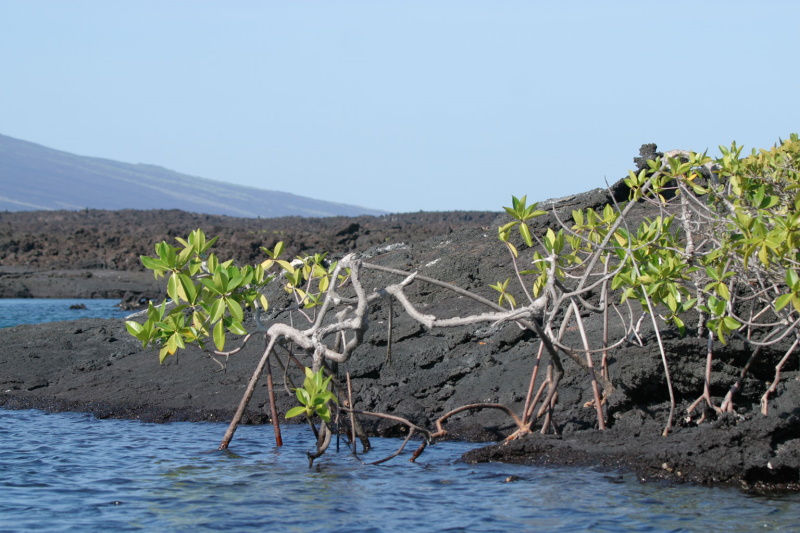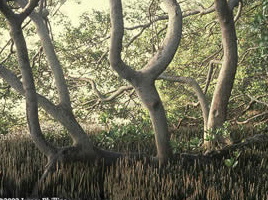Types of Mangroves
What are Mangroves?
Mangroves are tropical plants which are found along much of the world's tropical coasts. They grow in loose, wet soils, salt water, and are periodically submerged by tidal flows. Their distribution throughout the world is affected by climate, salinity of the water, fluctuation of the tides, type of soil in the area and, more recently, by development of tidal wetlands for residential use as well as industrial, i.e. shrimp farms.
Florida has 3 of the 50 species of Mangroves found throughout the world.
Red Mangrove (Rhizophora Mangle)
- The Red Mangrove - also known as the 'Walking Tree' - can be identified by the trunk roots which have a reddish color to the bark.
- They have shiny deep green leaves which are lighter on the underside. The leaves measure 1-5 inches in length and are broad and blunt at the tip.
- Their prop roots - arching out from the trunk and the branches, produce additional roots and give the tree the appearance that it is walking into the water.

The red mangroves are the first flora to populate a volcanic island in the Galapagos Islands of Ecuador.
The survival of this tree in brackish water is a direct result of the tree's ability to adapt to its environment by using its roots to remove 99/100ths of the salt from the water it drinks. Red Mangrove tissue samples, when analyzed, revealed that the salt content of the water in those samples had approximately 1/100th of the salt found in the water in which the trees were growing.
The Red Mangrove produces bud-like growths which grow into torpedo-shaped seedlings known as propagules. These seedlings eventually fall into the water and either take root in the ground below or float and drift with the tides until suitable ground is found. A red mangrove propagule can drift for a year before rooting and producing a tree.
Black Mangrove (Avicennia Germinans)
Black Mangroves, larger and taller than the Red and White Mangroves because of their age, they are found upland of the Red Mangroves at higher elevations. These old timers are the most cold tolerant of the three species found in Florida. They can readily be identified by:
- Looking at the ground. These trees are surrounded by pneumatophores (prounounced "new-mat-afores"), stick-like structures (growths) - pointing skyward from the soil surrounding the trunk of the tree. Pneumatophores come from the roots of the Black Mangroves and help the tree to breathe. This species of mangrove generally grows in areas where the soil is saturated with water, without the pneumatophores, which act like a diver's snorkel, the tree would lack the oxygen it needs to survive.
- The bark of a Black Mangrove is dark.
- The leaves are shiny dark green on the top, oblong and pointed at the tip. The undersides of the leaves are a dull green color with short dense hairs - glands - which excrete salt the leaves serve as a back-up system for ridding the Black Mangrove of the salt that has not been excreted by the roots. When early settlers came to Florida they harvested salt from the Black Mangrove leaves.
- The seedlings produced by these trees are light green in color and shaped like large coins.

Black Mangoves surrounded by pneumatophores which provide their oxygen when they are submerged by tidal flows.
White Mangroves (Laguncularia Racemosa)
White Mangroves, usually found at higher elevations (further upland than the red or black mangroves) can easily be identified by:
- Their leaves which are light green in color, approximately 3 inches long, rounded at both ends, often having a notch in the tip.
- At the base of their leaves, where the leaves meet the stems, you will find two bumps. These bumps are glands which excrete the salt found in the water.The seedlings of the White Mangrove are pod-shaped, about the size of a nickel and whitish in color.
Mangrove Functions and Values
- Mangroves trap and cycle various organic materials, chemical elements, and important nutrients in the coastal eco-system.
- Mangroves provide one of the basic food chain resources for marine organisms. The leaves of mangroves last for approximately a year before falling into the water where bacteria and fungus decompose the leaves, these leaves form the base of the food chain. The mixture of decaying plant material, soil, water, fungus and bacteria makes up Detritus (pronounced "di-tri-tes") which provides food for marine organisms, i.e. crabs, shrimps, oysters, claims, anchovies, mullets. These marine species in turn provide food for larger species, i.e. Snook, Seatrout, Red Drum and Pinfish, Mangrove Snapper, Tarpon, which in turn provide food for Bottle Nosed Dolphins, Bull Sharks, Alligators, pelicans, Great Blue Herons, Egrets, Wood Storks, Eagles, Osprey, and humans.
- Mangroves provide physical habitat and nursery grounds for a wide variety of marine organisms, many of which have important recreational or commercial value. For example, the pneumataphores of the Black Mangrove provide safety for many marine animals, sheltering crabs, shrimp, fish and clams, protecting many from predators.
- Mangroves serve as storm buffers by reducing wind and wave action in shallow shoreline areas.
- Mangrove seedlings unlike other plants whose seedlings need to be germinated, are alive and ready to grow. The moment they are dropped from the parent plant they have the ability to take root and produce trees.
An estimated 500,000 acres of mangroves remain in the coastal areas of Central and South Florida. It is estimated that approximately 80% are under governmental or private ownership or control for conservation and preservation purposes.